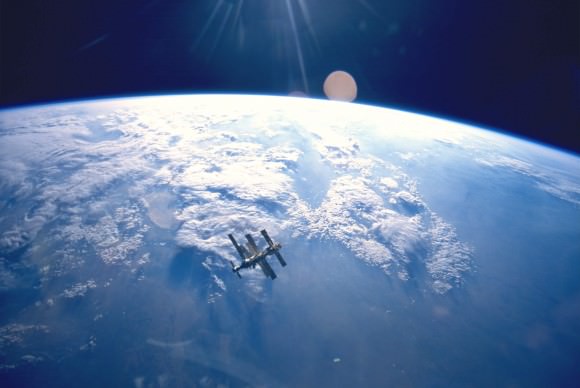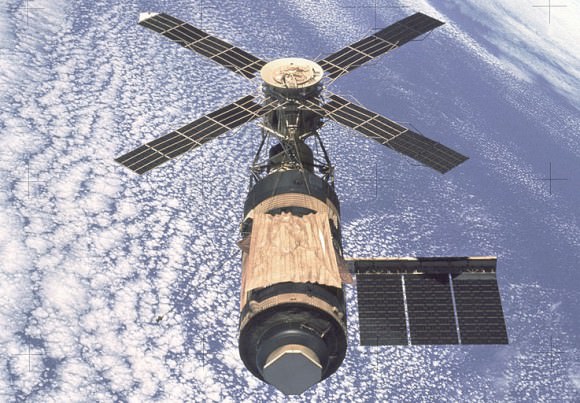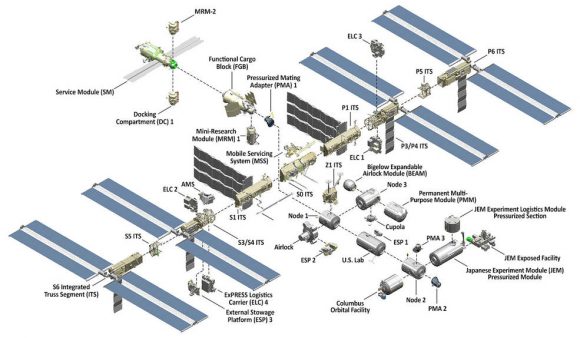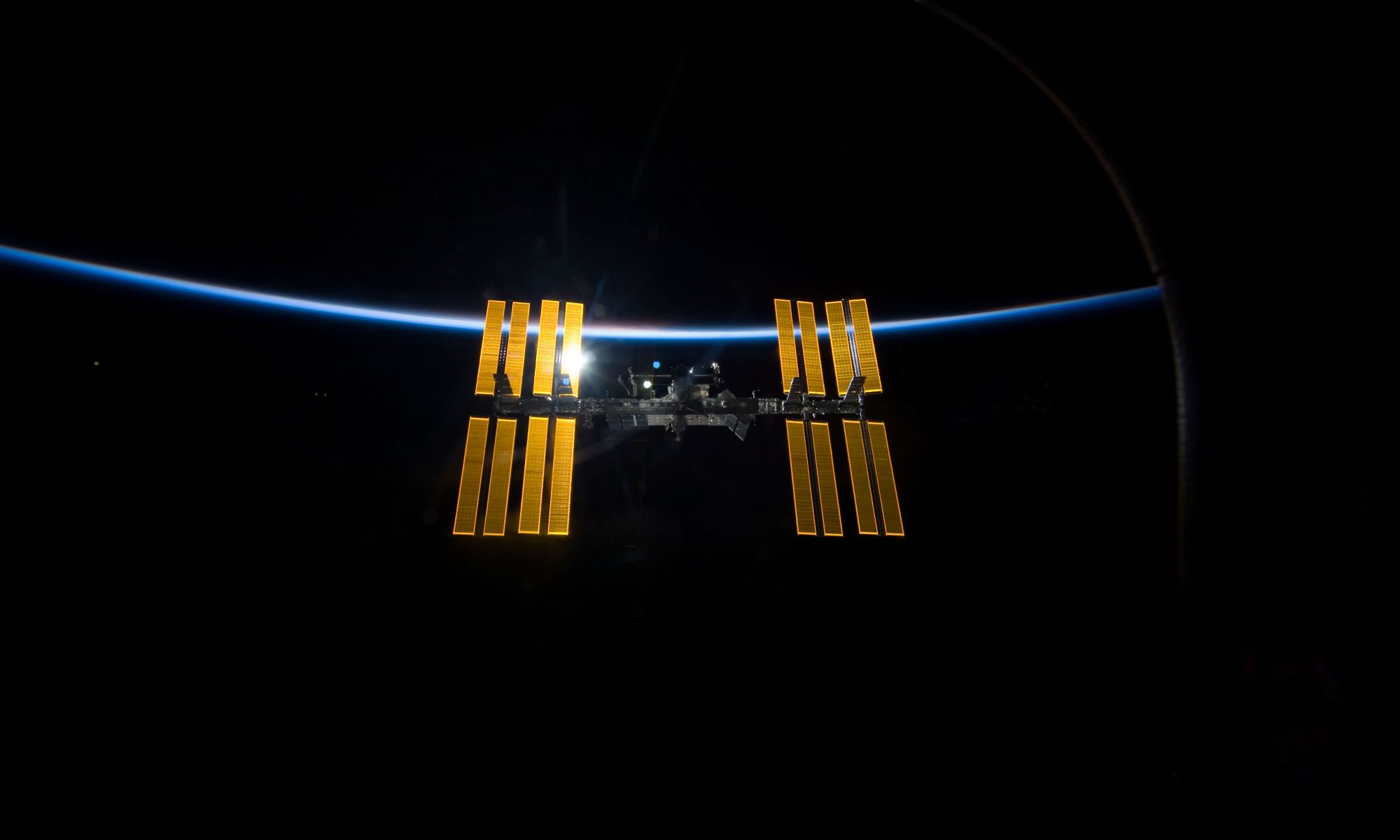After the historic Apollo Missions, which saw humans set foot on another celestial body for the first time in history, NASA and the Russian Space Agency (Roscosmos) began to shift their priorities away from pioneering space exploration and began to focus on developing long-term capabilities in space. In the ensuing decades (from the 1970s to 1990s), both agencies began to build and deploy space stations, each one bigger and more complex than the last.
The latest and greatest of these is the International Space Station (ISS), a scientific facility that resides in Low-Earth Orbit around our planet. This space station is the largest and most sophisticated orbiting research facility ever built and is so large that it can actually be seen with the naked eye. Central to its mission is the idea of fostering international cooperation for the sake of advancing science and space exploration.
Origin:
Planning for the ISS began in the 1980s and was based in part on the successes of Russia’s Mir space station, NASA’s Skylab, and the Space Shuttle Program. This station, it was hoped, would allow for the future utilization of low-Earth Orbit and its resources, and serve as an intermediate base for renewed exploration efforts to the Moon, mission to Mars, and beyond.

In May of 1982, NASA established the Space Station task force, which was charged with creating a conceptual framework for such a space station. In the end, the ISS plan that emerged was a culmination of several different plans for a space station – which included NASA’s Freedom and the Soviet’s Mir-2 concepts, as well as Japan’s Kibo laboratory, and the European Space Agency’s Columbus laboratory.
The Freedom concept called for a modular space station to be deployed to orbit, where it would serve as the counterpart to the Soviet Salyut and Mir space stations. That same year, NASA approached the Japanese Aerospace and Exploration Agency (JAXA) to participate in the program with the creation of the Kibo, also known as the Japanese Experiment Module.
The Canadian Space Agency was similarly approached in 1982 and was asked to provide robotic support for the station. Thanks to the success of the Canadarm, which was an integral part of the Space Shuttle Program, the CSA agreed to develop robotic components that would assist with docking, perform maintenance, and assist astronauts with spacewalks.
In 1984, the ESA was invited to participate in the construction of the station with the creation of the Columbus laboratory – a research and experimental lab specializing in materials science. The construction of both the Kibo and Columbus modules was approved in 1985. As the most ambitious space program in either agency’s history, the development of these laboratories was seen as central to Europe and Japan’s emerging space capability.

In 1993, American Vice-President Al Gore and Russian Prime Minister Viktor Chernomyrdin announced that they would be pooling the resources intended to create Freedom and Mir-2. Instead of two separate space stations, the programs would be working collaboratively to create a single space station – which was later named the International Space Station.
Construction:
Construction of the ISS was made possible with the support of multiple federal space agencies, which included NASA, Roscosmos, JAXA, the CSA, and members of the ESA – specifically Belgium, Denmark, France, Spain, Italy, Germany, the Netherlands, Norway, Switzerland, and Sweden. The Brazilian Space Agency (AEB) also contributed to the construction effort.
The orbital construction of the space station began in 1998 after the participating nations signed the Space Station Intergovernmental Agreement (IGA), which established a legal framework that stressed cooperation based on international law. The participating space agencies also signed the Four Memoranda of Understandings (MoUs), which laid out their responsibilities in the design, development, and use of the station.
The assembly process began in 1998 with the deployment of the ‘Zarya’ (“Sunrise” in Russian) Control Module, or Functional Cargo Block. Built by the Russians with funding from the US, this module was designed to provide the station’s initial propulsion and power. The pressurized module – which weighed over 19,300 kg (42,600 pounds) – was launched aboard a Russian Proton rocket in November 1998.
On Dec. 4th, the second component – the ‘Unity’ Node – was placed into orbit by the Space Shuttle Endeavour (STS-88), along with two pressurized mating adapters. This node was one of three – Harmony and Tranquility being the other two – that would form the ISS’ main hull. On Sunday, Dec. 6th, it was mated to Zarya by the STS-88 crew inside the shuttle’s payload bay.
The next installments came in the year 2000, with the deployment of the Zvezda Service Module (the first habitation module) and multiple supply missions conducted by the Space Shuttle Atlantis. The Space Shuttle Discovery (STS-92) also delivered the station’s third pressurized mating adapted and a Ku-band antenna in October. By the end of the month, the first Expedition crew was launched aboard a Soyuz rocket, which arrived on Nov. 2nd.
In 2001, the ‘Destiny’ Laboratory Module and the ‘Pirs’ Docking Compartment were delivered. The modular racks that are part of Destiny were also shipped using the Raffaello Multi-Purpose Logistic Modules (MPLM) aboard the Space Shuttle Endeavour and put into place using the Canadarm2 robotic arm. In 2002, additional racks, truss segments, solar arrays, and the Mobile Base System for the Station’s Mobile Servicing System were all delivered.
In 2007, the European Harmony module was installed, which allowed for the addition of the Columbus and Kibo laboratories – both of which were added in 2008. Between 2009 and 2011, construction was finalized with the addition of the Russian Mini-Research Module-1 and -2 (MRM1 and MRM2), the ‘Tranquility’ Node, the Cupola Observation Module, the Leonardo Permanent Multipurpose Module, and the Robonaut 2 technology suite.

No additional modules or components were added until 2016 when Bigelow Aerospace installed their experimental Bigelow Expandable Activity Module (BEAM). All told, it took 13 years to construct the space station, an estimated $100 billion and required more than 100 rocket and Space Shuttle launches, and 160 spacewalks.
As of the penning of this article, the station has been continuously occupied for a period of 16 years and 74 days since the arrival of Expedition 1 on November 2nd, 2000. This is the longest continuous human presence in low Earth orbit, having surpassed Mir’s record of 9 years and 357 days.
Purpose and Aims:
The main purpose of the ISS is fourfold: conducting scientific research, furthering space exploration, facilitating education and outreach, and fostering international cooperation. These goals are backed by NASA, the Russian Federal Space Agency (Roscomos), the Japanese Aerospace Exploration Agency (JAXA), the Canadian Space Agency (CSA), and the European Space Agency (ESA), with additional support from other nations and institutions.
As far as scientific research goes, the ISS provides a unique environment to conduct experiments under microgravity conditions. Whereas crewed spacecraft provide a limited platform that is only deployed to space for a limited amount of time, the ISS allows for long-term studies that can last for years (or even decades).
Many different and continuous projects are being conducted aboard the ISS, which are made possible with the support of a full-time crew of six astronauts, and a continuity of visiting vehicles (which also allows for resupply and crew rotations). Scientists on Earth have access to their data and are able to communicate with the science teams through a number of channels.
The many fields of research conducted aboard the ISS include astrobiology, astronomy, human research, life sciences, physical sciences, space weather, and meteorology. In the case of space weather and meteorology, the ISS is in a unique position to study these phenomena because of its position in LEO. Here, it has a short orbital period, allowing it to witness weather across the entire globe many times in a single day.
It is also exposed to things like cosmic rays, solar wind, charged subatomic particles, and other phenomena that characterize a space environment. Medical research aboard the ISS is largely focused on the long-term effects of microgravity on living organisms – particularly its effects on bone density, muscle degeneration, and organ function – which is intrinsic to long-range space exploration missions.
The ISS also conducts research that is beneficial to space exploration systems. Its location in LEO also allows for the testing of spacecraft systems that are required for long-range missions. It also provides an environment where astronauts can gain vital experience in terms of operations, maintenance, and repair services – which are similarly crucial for long-term missions (such as missions to the Moon and Mars).
The ISS also provides opportunities for education thanks to participation in experiments, where students are able to design experiments and watch as ISS crews carry them out. ISS astronauts are also able to engage classrooms through video links, radio communications, email, and educational videos/web episodes. Various space agencies also maintain educational materials for download based on ISS experiments and operations.
Educational and cultural outreach also fall within the ISS’ mandate. These activities are conducted with the help and support of the participating federal space agencies and are designed to encourage education and career training in the STEM (Science, Technical, Engineering, Math) fields.
One of the best-known examples of this is the educational videos created by Chris Hadfield – the Canadian astronaut who served as the commander of Expedition 35 aboard the ISS – which chronicled the everyday activities of ISS astronauts. He also directed a great deal of attention to ISS activities thanks to his musical collaboration with the Barenaked Ladies and Wexford Gleeks – titled “I.S.S. (Is Somebody Singing)” (shown above).
His video, a cover of David Bowie’s “Space Oddity”, also earned him widespread acclaim. Along with drawing additional attention to the ISS and its crew operations, it was also a major feat since it was the only music video ever to be filmed in space!
Operations Aboard the ISS:
As noted, the ISS is facilitated by rotating crews and regular launches that transport supplies, experiments, and equipment to the station. These take the form of both crewed and uncrewed vehicles, depending on the nature of the mission. Crews are generally transported aboard Russian Progress spacecraft, which are launched via Soyuz rockets from the Baikonur Cosmodrome in Kazakhstan.
Roscosmos has conducted a total of 60 trips to the ISS using Progress spacecraft, while 40 separate launches were conducted using Soyuz rockets. Some 35 flights were also made to the station using the now-retired NASA Space Shuttles, which transported crew, experiments, and supplies. The ESA and JAXA have both conducted 5 cargo transfer missions, using the Automated Transfer Vehicle (ATV) and the H-II Transfer Vehicle (HTV), respectively.
In more recent years, private aerospace companies like SpaceX and Orbital ATK have been contracted to provide resupply missions to the ISS, which they have done using their Dragon and Cygnus spacecraft. Additional spacecraft, such as SpaceX’s Crew Dragon spacecraft, are expected to provide crew transportation in the future.
Alongside the development of reusable first-stage rockets, these efforts are being carried out in part to restore domestic launch capability to the US. Since 2014, tensions between the Russian Federation and the US have led to growing concerns over the future of Russian-American cooperation with programs like the ISS.
Crew activities consist of conducting experiments and research considered vital to space exploration. These activities are scheduled from 06:00 to 21:30 hours UTC (Universal Coordinated Time), with breaks being taken for breakfast, lunch, dinner, and regular crew conferences. Every crew member has their own quarters (which includes a tethered sleeping bag), two of which are located in the Zvezda Module and four more installed in Harmony.
During “night hours”, the windows are covered to give the impression of darkness. This is essential since the station experiences 16 sunrises and sunsets a day. Two exercise periods of 1 hour each are scheduled every day to ensure that the risks of muscle atrophy and bone loss are minimized. The exercise equipment includes two treadmills, the Advanced Resistive Exercise Device (ARED) for simulated weight training, and a stationary bicycle.
Hygiene is maintained thanks to water jets and soap dispensed from tubes, as well as wet wipes, rinseless shampoo, and edible toothpaste. Sanitation is provided by two space toilets – both of Russian design – aboard the Zvezda and Tranquility Modules. Similar to what was available aboard the Space Shuttle, astronauts fasten themselves to the toilet seat and the removal of waste is accomplished with a vacuum suction hole.
Liquid waste is transferred to the Water Recovery System, where it is converted back into drinking water (yes, astronauts drink their own urine, after a fashion!). Solid waste is collected in individual bags that are stored in an aluminum container, which are then transferred to the docked spacecraft for disposal.
Food aboard the station consists mainly of freeze-dried meals in vacuum-sealed plastic bags. Canned goods are available, but are limited due to their weight (which makes them more expensive to transport). Fresh fruit and vegetables are brought during resupply missions, and a large array of spices and condiments are used to ensure that food is flavorful – which is important since one of the effects of microgravity is a diminished sense of taste.
To prevent spillage, drinks and soups are contained in packets and consumed with a straw. Solid food is eaten with a knife and fork, which are attached to a tray with magnets to prevent them from floating away, while drinks are provided in dehydrated powder form and then mixed with water. Any food or crumbs that floats away must be collected to prevent them from clogging the air filters and other equipment.
Hazards:
Life aboard the station also carries with it a high degree of risk. These come in the form of radiation, the long-term effects of microgravity on the human physique, the psychological effects of being in space (i.e. stress and sleep disturbances), and the danger of collision with space debris.
In terms of radiation, objects within the Low-Earth Orbit environment are partially protected from solar radiation and cosmic rays by the Earth’s magnetosphere. However, without the protection of the Earth’s atmosphere, astronauts are still exposed to about 1 millisievert a day, which is the equivalent of what a person on Earth is exposed to during the course of a year.
As a result, astronauts are at higher risk for developing cancer, suffering DNA and chromosomal damage, and diminished immune system function. Hence why protective shielding and drugs are a must aboard the station, as well as protocols for limiting exposure. For instance, during solar flare activity, crews are able to seek shelter in the more heavily shielded Russian Orbital Segment of the station.
As already noted, the effects of microgravity also take a toll on muscle tissues and bone density. According to a 2001 study conducted by NASA’s Human Research Program (HRP) – which researched the effects on an astronaut Scott Kelly’s body after he spent a year aboard the ISS – bone density loss occurs at a rate of over 1% per month.
Similarly, a report by the Johnson Space Center – titled “Muscle Atrophy” – stated that astronauts experience up to a 20% loss of muscle mass on spaceflights lasting just five to 11 days. In addition, more recent studies have indicated that the long-term effects of being in space also include diminished organ function, decreased metabolism, and reduced eyesight.
Because of this, astronauts exercise regularly in order to minimize muscle and bone loss, and their nutritional regimen is designed to make sure they the appropriate nutrients to maintain proper organ function. Beyond that, the long-term health effects, and additional strategies to combat them, are still being investigated.
But perhaps the greatest hazard comes in the form of orbiting junk – aka. space debris. At present, there are over 500,000 pieces of debris that are being tracked by NASA and other agencies as they orbit the Earth. An estimated 20,000 of these are larger than a softball, while the remainder are about the size of a pebble. All told, there are likely to be many millions of pieces of debris in orbit, but most are so small they can’t be tracked.
These objects can travel at speeds of up to 28,163 km/h (17,500 mph), while the ISS orbits the Earth at a speed of 27,600 km/h (17,200 mph). As a result, a collision with one of these objects could be catastrophic to the ISS. The station is naturally shielded to withstand impacts from tiny bits of debris and well as micro-meteoroids – and this shielding is divided between the Russian Orbital Segment and the US Orbital Segment.
On the USOS, the shielding consists of a thin aluminum sheet that is held apart from the hull. This sheet causes objects to shatter into a cloud, thereby dispersing the kinetic energy of the impact before it reaches the main hull. On the ROS, shielding takes the form of a carbon plastic honeycomb screen, an aluminum honeycomb screen, and glass cloth, all of which are spaced over the hull.
The ROS’ shielding is less likely to be punctured, hence why the crew moves to the ROS whenever a more serious threat presents itself. But when faced with the possibility of an impact from a larger object that is being tracked, the station performs what is known as a Debris Avoidance Manoeuvre (DAM). In this event, the thrusters on the Russian Orbital Segment fire in order to alter the station’s orbital altitude, thus avoiding the debris.
Future of the ISS:
Given its reliance on international cooperation, there have been concerns in recent years – in response to growing tensions between Russia, the United States, and NATO – about the future of the International Space Station. However, for the time being, operations aboard the station are secure, thanks to commitments made by all of the major partners.
In January of 2014, the Obama Administration announced that it would be extending funding for the US portion of the station until 2024. Roscosmos has endorsed this extension but has also voiced approval for a plan that would use elements of the Russian Orbital Segment to construct a new Russian space station.
Known as the Orbital Piloted Assembly and Experiment Complex (OPSEK), the proposed station would serve as an assembly platform for crewed spacecraft traveling to the Moon, Mars, and the outer Solar System. There have also been tentative announcements made by Russian officials about a possible collaborative effort to build a future replacement for the ISS. However, NASA has yet to confirm these plans.
In April of 2015, the Canadian government approved a budget that included funding to ensure the CSA’s participation with the ISS through 2024. In December of 2015, JAXA and NASA announced their plans for a new cooperative framework for the International Space Station (ISS), which included Japan extending its participation until 2024. As of December 2016, the ESA has also committed to extending its mission to 2024.
The ISS represents one of the greatest collaborative and international efforts in history, not to mention one of the greatest scientific undertakings. In addition to providing a location for crucial scientific experiments that cannot be conducted here on Earth, it is also conducting research that will help humanity make its next great leaps in space – i.e. mission to Mars and beyond!
On top of all that, it has been a source of inspiration for countless millions who dream of going to space someday! Who knows what great undertakings the ISS will allow for before it is finally decommissioned – most likely decades from now?
We have written many interesting articles about the ISS here at Universe Today. Here’s International Space Station Achieves 15 Years of Continuous Human Presence in Orbit, Beginner’s Guide to Seeing the International Space Station, Take a Virtual 3-D Spacewalk Outside the International Space Station, International Space Station Viewing, and Space Station Pictures.
For more information, check out the NASA Reference Guide to the ISS and this article about the 10th anniversary of the space station.
Astronomy Cast also has relevant episodes on the subject. Here’s Questions: An Unlocked Moon, Energy Into Black Holes, and the Space Station’s Orbit, and Episode 298: Space Stations, Part 3 – International Space Station.
Sources:

